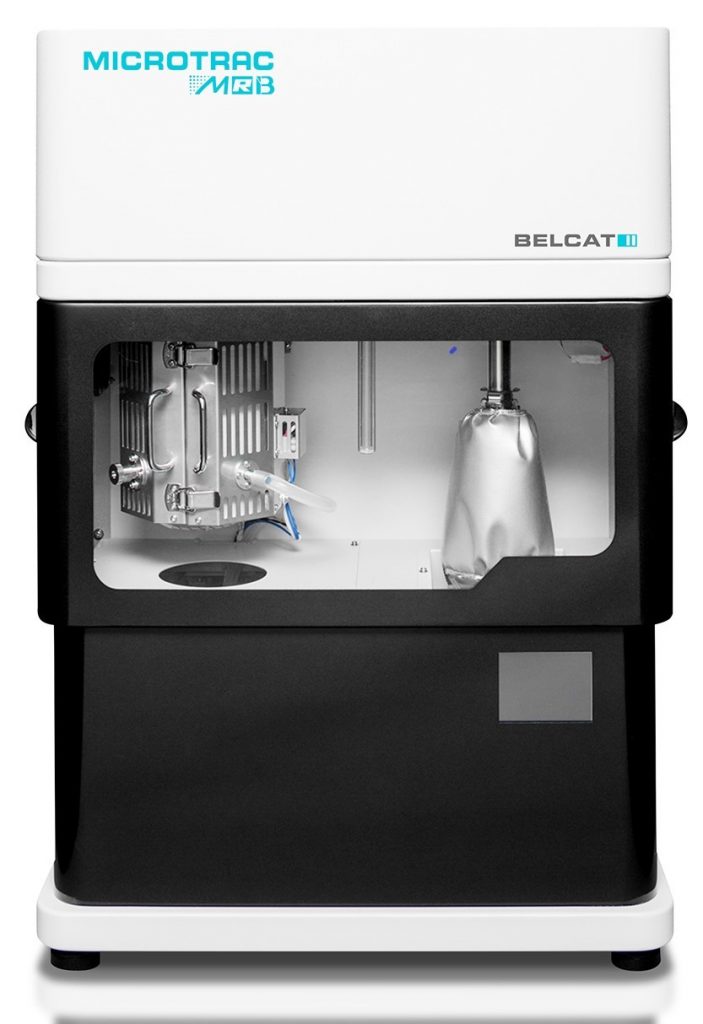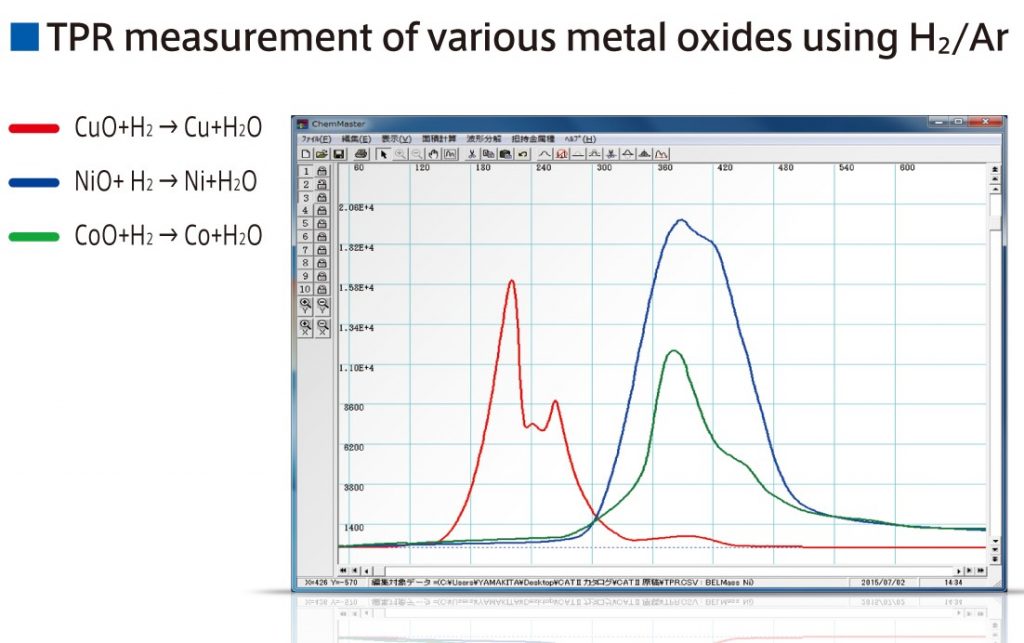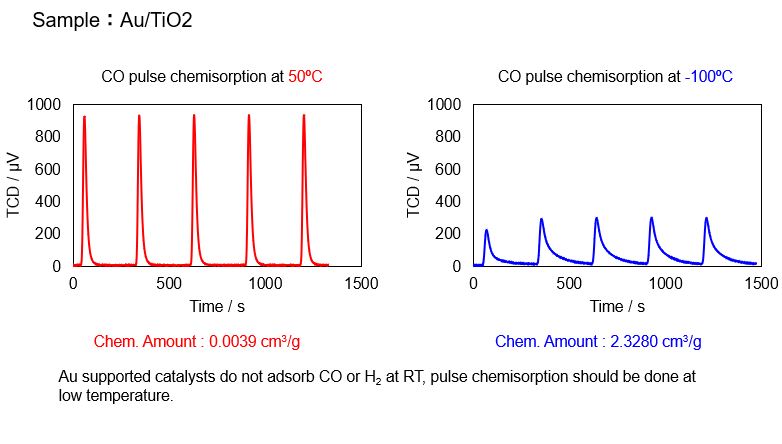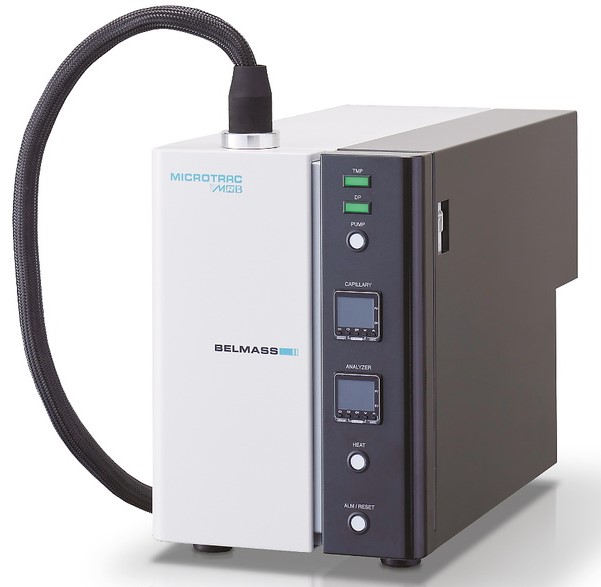This product line is manufactured by MicrotracBEL-Japan, specialist in adsorption. MicrotracBEL, RETSCH Technology and Microtrac bring together a wide expertise in particle characterization under a strong brand name: Microtrac MRB GmbH.
CATALYST ANALYZER
BELCAT II

The catalyst analyzer BELCAT II is a fully automated chemisorption device which enables comprehensive evaluation and characterization of solid catalysts by means for dynamic gas flow method. Typical performed measurements are:
- Metal dispersion rate on metal support catalyst by pulse chemisorption. Furthermore, pulse chemisorption measurement determines metal surface area and particle size as well
- Catalyst’s acidity or basicity measured by temperature programed desorption spectra
- Reduction/Oxidation properties of a catalytic reaction with respect to temperature: Temperature Programmed Reduction/Oxidation (TPR/TPO)
- Reactivity of adsorbed molecules with Temperature Programmed Reaction (TPRea). Further, BELCAT II chemisorption analyzer measures BET single point, adsorption rate and Breakthrough Curve Measurement evaluation o for example molecular sieves
Application example 1:
 Evaluation of Oxygen Release Capacity (ORC) and Oxygen Storage Capacity (OSC).
Evaluation of Oxygen Release Capacity (ORC) and Oxygen Storage Capacity (OSC).
On a 3-way catalyst, its primary function is to convert and minimize emissions of harmful species like CO, HC, and NOx by simultaneously oxidation and reduction of exhaust gases. Since the conversion efficiency depends upon air/fuel ratio, for NO a low a/f ratio is desirable while for CO and HC a high a/f ratio is best, this kind of catalysts should possess high OSC. During service conditions a 3-way catalyst can store oxygen from the exhaust gas stream, usually when the air fuel ratio goes high. When insufficient oxygen is available from the exhaust stream, the stored oxygen is released and consumed. BELCATII enables the evaluation of oxygen release capacity (ORC) from the H2 consumption by H2-TPR measurements and OSC by O2 pulse chemisorption.
Application example 2:
Pulse chemisorption at low T: BELCATII + CatCryo II

During pulse chemisorption the adsorptive gas should not react with the substrate because it would consume the oxygen stored on the supported material causing an overestimation of the metal dispersion rate. CO pulse chemisorption on CeO2 supported catalyst is an example for this case. In this case, the reactivity of the CO towards the oxide is overcome by performing measurements at temperatures below -50 °C, that is possible using the cryogenic unit CatCryo II. On the other hand, this cryogenic unit can also be used to promote adsorption on the supported metal when temperature conditions are not favorable, like for example on Au/TiO2 catalyst, neither CO nor H2 will be adsorbed by Au at RT then measurements should be carried out at lower temperatures.
PRODUCT ADVANTAGES
- Compact and affordable chemisorption device
- BELCATII uses a split electrical furnace equipped with cooling fan and safety cover which is automatically locked when temperature exceeds 50 °C
- Highly sensitive 4-element thermal conductivity detector (TCD) which features a switchable function high/low sensitivity
- Unique gas flow design with a standard gas mix line
- Cleaver triple sample tube design: inner tube to contain the thermocouple, hollow middle tube to insure good has circulation and an outer tube which holds the sample
- Optional items like vapor set, Cat Cryo II, extra gas mixing unit and N2O pulse chemisorption with column option
- The pulse loop with temperature/pressure sensor enables the highly reproducible result
- Makes a great chemisorption duo with our own gas analyzers BELMASS II but it can also be connected to other gas analyzers like GC or IR
GAS ANALYZER
BELMASS II

BELMASS II features a small footprint quadrupole mass spectrometer (QMS) for multicomponent gas analysis. QMS consists of four cylindrical rods (quadrupole mass filter) arranged parallel to each other. By applying an oscillating electric field ions are filtrated based on the stability of their trajectories as a function of their mass-to-charge ratio (m/z) and an electron multiplier detects the deflected ions. BELMASS II can be combined with various instruments. Combined with BELCAT II it provides important information about the species of the desorbed gases from gas/vapor mixtures and their breakthrough curves.
Main Features
- SUS capillary tube and built in
- Heated hose enables the analysis of vapors
- Max. temperature of sniffer probe in heater hose 200°C (SUS), 120°C (PEEK, optional)
- Built-in diaphragm pump (backing pump for TMP)
- Mass range 1-200 a.m.u.
- Faraday cup / secondary electron multiplier
- Min. detection limit: < 1ppm (gas dependent)
- Scan speed: Auto, 0.01, 0.03, 0.1, 0.3, 1, 3, 10 sec/a.m.u.
- 16 measurement channels
- Analysis software Quadvision2 as stand alone device, otherwise it can be controlled by BELCATII’s software
- Analysis Software ChemMasterII to perform: spectrum image display, spectrum processing and area calculation, baseline correction and spike noise filter function among others. Distribution Fitting function for peak deconvolution function which allows to split the measured spectrum into multiple peaks thereby determining the number of active sites present on the catalyst surface. Analyses of pulse measurement spectrum. ..
PRODUCT ADVANTAGES
- Small footprint and affordable Q-mass Spectrometer
- Low gas consumption rate, about 1.0 cc/min
- High response speed, about 1 second, from gas sampling to detection
- High sensitivity, by switching from Faraday cup to SEM detector
- Top mounted capillary tubing
- Safety functions for automated stop
- Analysis software Quadvision2 as stand alone device, or controlled by BELCATII’s software
